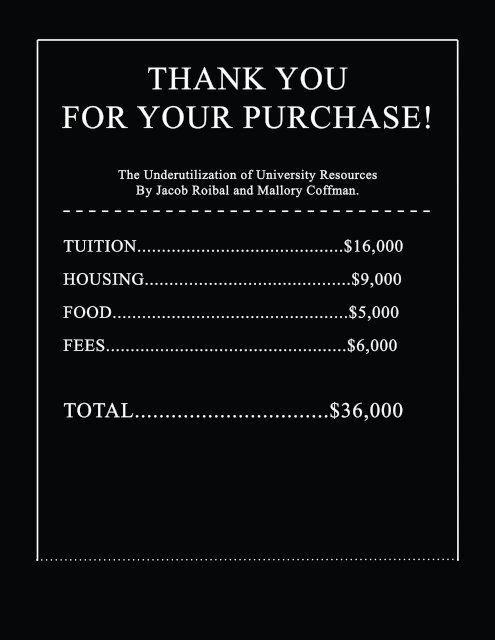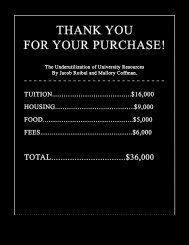Final12
You also want an ePaper? Increase the reach of your titles
YUMPU automatically turns print PDFs into web optimized ePapers that Google loves.
THANK YOU<br />
FOR YOUR PURCHASE!<br />
The Underutilization of University Resources<br />
By Jacob Roibal and Mallory Coffman.<br />
TUITION..........................................$16,000<br />
HOUSING..........................................$9,000<br />
FOOD................................................$5,000<br />
FEES.................................................$6,000<br />
TOTAL................................$36,000
TABLE<br />
OF<br />
CONTENTS.
1<br />
2<br />
4<br />
6<br />
8<br />
10<br />
12-25<br />
INTRODUCTION<br />
USE OF UNIVERSITY RESOURCES<br />
STUDENT MENTAL HEALTH CRISIS<br />
IMPACT ON STUDENT SUCCESS<br />
SOLUTIONS<br />
DESIGN SOLUTIONS<br />
BUILDING DESIGN
INTRODUCTION.
Students pay obscene amounts of money attached to<br />
their tuition to support resources and programs they<br />
will never use if they even hear about them all. The<br />
average student pays fees of $6,000 annually.<br />
You pay for it, why not use it?<br />
Often students find themselves afraid to seek help<br />
when they require it for mental health and/or academic<br />
support.<br />
This happens when a stigma surrounds a resource<br />
which deters students from its benefit. For example,<br />
many students fear counseling services because they<br />
may seem weak by their peers. Another is when<br />
someone struggling academically may refuse resources<br />
as to not look unintelligent.<br />
The only one who loses out is the one who does not<br />
seek help.<br />
1
USE OF UNIVERSITY RESOURCES<br />
Although student resources are available, they<br />
are extremely under-utilized when looking at the<br />
number of struggling students where available<br />
resources would keep them from dropping out,<br />
committing suicide, or performing poorly in school.<br />
75% 86%<br />
of students in the<br />
mental illness<br />
category did not seek<br />
counseling through<br />
available college<br />
resources.<br />
of students who<br />
died from suicide<br />
did not seek any<br />
help from school<br />
counselling<br />
resources.<br />
2
STUDENTS PER YEAR<br />
2.34 MILLION<br />
RECIEVE TUTORING<br />
28.9%<br />
DROPOUTS<br />
40%<br />
GRADUATE<br />
60%<br />
Each year in the US, 2.34 million new students<br />
embark on their college journey. Out of that<br />
massive pool, only 28.9% attempt tutoring and less<br />
than 20% of undergraduate students reach out to<br />
career centers. Because of this and various other<br />
reasons, 40% of students drop out of college, and<br />
only 1.4 million students reach graduation.<br />
3
Suicide is the #2 leading cause of death in college students.<br />
STUDENT MENTAL HEALTH CRISIS<br />
2 in 3 students have a mental health<br />
problem<br />
In a 2019 study consisting of over 90,000 students on over 133 college campuses,<br />
60% of students fit the criteria for one or more mental health problems. Rates of<br />
mental health problems are steady over all races, however, students of color are less<br />
likely to seek help. Counseling centers are overwhelmed, have long waiting lists,<br />
and have burned out counselors.<br />
Suicidal Thoughts<br />
15%<br />
Depression<br />
44%<br />
Anxiety<br />
38%<br />
4
Less than 25% of students who have a mental illness seek help<br />
PERCENTAGE OF STUDENTS THAT REACHED OUT BY RACE<br />
WHY?<br />
Stigmas surrounding mental health come in different forms but all percieve<br />
people with a mental illness in a negative light. Some of these perceptions refer<br />
to stereotypes that they are weak, dangerous, unpredictable, or even just attention<br />
seeking. A study has found that racial minorities are especially held against these<br />
mental health stigmas, leading to their relectance in reaching out for help.<br />
72% of counselors are white. Racial minorites may feel a disconnect with a white<br />
counselor. Minority students may feel more validated or comforted by someone<br />
with the same ethnic background as them and able to provide help for their unique<br />
cultural experiences. It is important for students to feel like they can trust a therapist<br />
with their problems.<br />
Cultural norms, similar to stigmas, deal with values or perceptions that people with<br />
mental illnesses are weak. Many individuals from racial minority backgrounds fear<br />
that seeking mental health treatment will reinforce negative stereotypes or lead to<br />
further discrimination, so they may avoid seeking help altogether.<br />
Academic pressure is higher for minority students that are combating racial<br />
stereotypes. Whether this is imposed by themselves, their family or community, it<br />
may lead to minority students prioritizing their academic success over mental health.<br />
5
IMPACT ON STUDENT SUCCESS<br />
Of undergraduate students reported that they had considered dropping out<br />
of college in their first year due to emotional stress.<br />
Students with depression are 2x as likely to have discontionous<br />
enrollment<br />
The transition from high school to college can be overwhelming, students begin<br />
dealing with seperation anxiety and a new set of responsibilities. The pressure<br />
to succeed academically, coupled with uncertainty about their chosen major or<br />
career path, can intensify stress and anxiety. Additionally, students may face social<br />
pressures, including the desire to fit in and make new friends, which can exacerbate<br />
feelings of loneliness and isolation. The combination of these factors, along with the<br />
absence of established support networks, can strain students’ mental health and make<br />
the first year of college particularly challenging.<br />
6
Mild to severe depression leads to an average -0.2 change in GPA<br />
This number increases to -0.4 when the depression lasts for over six months.<br />
Students dealing with depression have a harder time maintaining enough motivation<br />
to get good grades. The pervasive feelings of sadness, hopelessness, and fatigue<br />
associated with depression can hinder a student’s ability to concentrate, attend<br />
classes regularly, complete assignments, and prepare for exams.<br />
Of students reported with mental illness, those who received treatment<br />
were 51% less likely to drop out<br />
Research proves that students who were treated for their mental health felt more<br />
capable to their school work and learn. College campuses offer a range of support<br />
services, including counseling and therapy, that are readily accessible to students.<br />
By seeking help, students can gain the necessary tools and support to navigate the<br />
challenges they face, ultimately promoting not only their mental health but also their<br />
educational and personal growth during their college years.<br />
7
1 in 3 students in college fall into at least on mental illness category.<br />
Compared to 20% of high school students, over 60% of college<br />
students have reported to feel depressed, have anxiety, or thoughts of<br />
suicide.<br />
Solution ?<br />
Re Imagine education methods<br />
Knowledge retention vs.<br />
knowledge application:<br />
Abolish exams<br />
The method of testing students through<br />
exams has been proven to negatively<br />
effect their self esteem, motivation for<br />
learning and sleep habits. These factors all<br />
contribute to depression and anxiety rates.<br />
Not only are these outdated methods of<br />
testing knowledge decreasing students<br />
mental health, exams are not the best way<br />
to check their knowledge. Memorizing<br />
information for an exam is not a true<br />
understanding of what is being taught.<br />
It would be more beneficial to students<br />
mental health and learning success if they<br />
were to practice knowledge application in<br />
a real world sense instead of memorizing<br />
8
GPA prioritized over<br />
learning<br />
Studies have found that students with a lower GPA are more<br />
likely to have depression and anxiety. However, stressing about<br />
grades is also a cause of depression and anxiety. This cycle<br />
overall negatively impacts students mental health. When students<br />
are focused on getting good grades, learning goals are no longer<br />
a priority. GPA competition among students has also been found<br />
to have the opposite effect, rather than being an incentive for<br />
students, it can actually lower their motivation.<br />
Lectures are a low level of learning<br />
“Students in classes<br />
with traditional<br />
stand-and-deliver<br />
lectures are 1.5<br />
times more likely<br />
to fail than students<br />
in classes that use<br />
more stimulating, socalled<br />
active learning<br />
methods.”<br />
A study was done in Harvard to compare a lecture based class and an active<br />
learning class, results found that students scored 10 percentage points lower on<br />
tests compared to their peers in active learning classrooms. The active learning<br />
class was student-centered and involved problem solving situations. When students<br />
feel better about their ability to learn and retain knowledge, their mental health<br />
increases.<br />
Eradicate the lecture hall<br />
A lecture hall holds a hierarchy where the professor stands in the front and presents<br />
information without any discussion or collaboration. Classrooms should be a place<br />
where students come to learn and collaborate together. Student centered learning is<br />
a newer way to check in and make sure that course content is being retained and can<br />
even work together in a real world scenario.<br />
9
Design Solutions<br />
Harkness Method Approach<br />
Developed by Edward Harkness, the Harkness teaching method removes the hierachy of old<br />
lecture style classrooms. It encourages open, student-led discussions around a communal<br />
table, fostering a sense of collaboration and intellectual exploration. This method promotes<br />
active engagement, critical thinking, and communication skills as students learn to express<br />
their ideas, listen to their peers, and construct knowledge collectively. By empowering<br />
students to take ownership of their education, it helps reduce anxiety and stress often<br />
associated with more traditional, teacher-centered methods. It builds self-confidence, as<br />
students learn to express themselves and develop a deeper understanding of the material<br />
through dialogue and debate. Additionally, the method emphasizes active listening, empathy,<br />
and social interaction, fostering a sense of community and emotional well-being. In this way,<br />
the Harkness Method not only enhances academic growth but also nurtures students’ overall<br />
mental health and well-rounded development.<br />
10
Natural Light<br />
It has been proven that increased hours of<br />
sunlight can help with levels of depression<br />
because it releases serotonin into the<br />
brain. Natural light in a student used space<br />
can be especially helpful because it can<br />
also increase brain productivity. Seasonal<br />
depression is found to be common among<br />
college students, natural sunlight can<br />
combat this during the winter months.<br />
Benefits<br />
1. Improves sleep<br />
2. Increase Vitamin D<br />
3. Happier mood<br />
4. Avoid seasonal<br />
depression<br />
5. Reduces stress and<br />
Student Centered<br />
Classrooms<br />
By getting rid of a lecture based<br />
education method, lecture halls<br />
will be eradicated from design.<br />
New, smaller breakout classrooms<br />
will allow students to be actively<br />
involved in their learning and<br />
collaborate with each other.<br />
11
12
13
14
15
16
17
18
19
20
21
23
24
25



